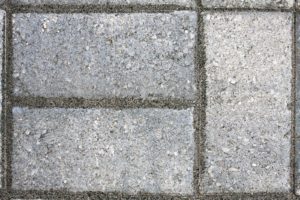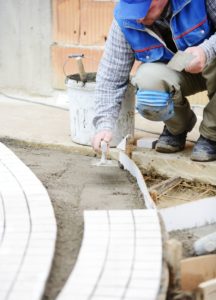A Guide to Concrete Pavers
Concrete pavers, sometimes called paving stones are a very popular building material used in a host of different outdoor projects. They are factory-made in a range of different shapes, colors, and sizes to suit any project. Like tiles, they arrive at the job site ready for installation.
 The paving bricks are typically laid on a base made up of compacted soil and/or sand. The joints between them aren’t grouted or sealed. This creates a permeable surface through which water can drain. The potential downside of this arrangement is that they can shift position over time. Weeds may also grow between the stones after this happens. When professionally-installed, they will last longer and give you fewer troubles. This is your best option for creating a great-looking, long-lasting walk, patio, or driveway.
The paving bricks are typically laid on a base made up of compacted soil and/or sand. The joints between them aren’t grouted or sealed. This creates a permeable surface through which water can drain. The potential downside of this arrangement is that they can shift position over time. Weeds may also grow between the stones after this happens. When professionally-installed, they will last longer and give you fewer troubles. This is your best option for creating a great-looking, long-lasting walk, patio, or driveway.
Concrete paving stones are frequently used in both residential and commercial construction work. They are designed to connect to each other. Because of this interlocking design, they create attractive patterns and are ready for use as soon as they’re installed. They offer some significant advantages over other outdoor flooring options and one of the best is that they can be taken up and then reinstalled at any time.
Common applications include creating driveways, walkways, and patios. Thanks to the nearly endless variety of colors, shapes, and patterns in which they are manufactured, you can find a suitable match for virtually any design concept.
Using For Sidewalks
If you’d like to create a sidewalk or walkway with a little more distinction than the typical rectangles of poured concrete used for the purpose, these paving bricks offer you tremendous versatility. You can make curved walks, vary your walkway widths as you desire, and introduce beautiful patterns to your paving. They let you create aesthetic effects similar to those you get from traditional brick or stone walks, but you have a wider range of color and shape choices, while also offering homeowners both durability and versatility. They can be incorporated into any sort of landscaping and significantly boost a home’s value.
 Some stones are manufactured with textured finishes that provide added traction, reducing the risks of slipping and falling. They can even be used in the garden to help you mark off the boundaries of planting beds.
Some stones are manufactured with textured finishes that provide added traction, reducing the risks of slipping and falling. They can even be used in the garden to help you mark off the boundaries of planting beds.
It’s true that installing them isn’t the cheapest hardscaping option available to you. That honor still goes to poured-in-place concrete. Poured concrete takes time to cure while paving stones are ready for use as soon as they’re installed. Installing them is also significantly cheaper than using natural stone for walkways.
Maintainance
The stones are rarely grouted to seal the gaps, however, professional contractors frequently use polymer sand to fill the joints. This sand includes an additive that binds the material together to create a tough, erosion-resistant surface that still allows drainage. The paving stones themselves are typically coated in a durable sealer. When installed properly, the walkway requires only occasional sweeping and rinsing to keep it looking its best.
The paving bricks will need to be installed on a properly-formed subbase in order to prevent settling. If they do settle, though, resetting them is extremely easy. Simply remove them, regrade the base and then put them back.
Most paving stones are manufactured with chamfered edges. This makes them easy to care for in the winter, as shovels will pass easily over them without chipping or dislodging the stones. Sharp implements shouldn’t be used to chop ice on them as this could cause damage. Professionals recommend either using a non-corrosive de-icing compound (e.g. calcium magnesium acetate) or sand to add traction. They should not be treated with calcium chloride or sodium chloride (rock salt) as this can permanently stain and damage them.
Tips For Buying And Installation

A durable walkway requires a properly prepared subgrade. Pedestrian walkways call for a base composed of 4 inches of compacted gravel covered by 1 inch of construction sand. Edging should also be installed if the stones do not abut concrete or another solid surface.
Check the statistical data before purchasing. You want stones with a compressive strength of at least 8,000 PSI and a water absorption rate of five percent or less.
Buy them with chamfered or beveled edges. This makes them easier to care for in the winter and also reduces the risk of tripping. Darker-colored pavers are a smart choice in cold climates, as they will melt snow more quickly. Try to choose a pattern which matches the space you intend to pave. Cutting individual bricks to fit will add significantly to the cost of your project. When you lay out walkways, use a width of at least three feet to accommodate ordinary traffic.
Pricing And Installation
Professional contractors who handle concrete pavers price their work on an installed basis, meaning that the total cost includes both the materials used and the labor required to install them. Several different factors affect this overall price, including:
- What sort of preparation needs to be done (e.g. removing existing pavement).
- Local material and labor costs.
- The overall complexity of your design.
- The size (square footage) of your project.
- The amount of subgrade material required.
Installation Steps
1) Check For Utility Conflicts
Before ground is broken, coordinate with your utility providers to ensure that your work is not going to disturb any buried wires or pipes. Mark any nearby utility lines for clarity.
2) Excavation
The first step is to remove existing pavement and soil down to the depth required to install them and their sub-surface base. The total depth is a combination of the thickness of the pavers, the depth of the setting bed, and the depth of base material. A soil engineer can provide precise requirements for the base material by accounting for the underlying soil’s ability to expand and contract. Standard base material thicknesses range from six to 12 inches. Driveway bases are usually 10 to 12 inches thick. Extreme soil conditions may require bases of up to 18 inches.
3) Compacting The Subgrade
The soil on which all subsequent materials are installed needs to be leveled and compacted. Dry, sandy soils can be compacted with a vibraplate. Clays require rollers or rammers.
4) Laying Geotextile Fabric
Geotextile fabric serves to keep the installed base material separate from the native soil. This is required in areas with wet climates and/or expansive soil.
5) Placing Base Material
Base material is installed in one or more lifts, never depositing more than four inches of material at once. The material should be compacted in between lifts.
 6) Installing Edge Restraints
6) Installing Edge Restraints
Edge restraints are necessary to provide lateral resistance to a finished concrete paver installation. They keep the individual pavers from shifting under heavy loads. The restraints are installed in the base material and steel spikes are used to secure them.
7) Installing The Setting Bed
The setting bed is made up of concrete sand, granite stone dust, or a similar material. This is spread over the base material in a layer one to one and a half inches thick.
8) Laying The Paving Stones
The stones are now installed according to the intended design. When mixed-color bricks are used, drawing from multiple pallets while working will provide even coloration on the finished project.
9) Installing Sand
Sand is swept over them and into the joints. Use a compactor to settle the sand and repeat the process as necessary to fill the joints.
10) Sealing
Use a properly-formulated sealant to protect them from damage and stains. Bear in mind that sealants typically require regular reapplication.
These concrete paving stones have become common materials for many residential and commercial projects. The range of different textures, patterns, and colors available make them popular for a wide range of different styles and tastes. Pavers are ready for immediate use as soon as they’re installed, and they can be easily removed and replaced if subsurface access is required.
Installing pavers is just one thing that Local Pavement Pros cover. We also handle other projects and concrete jobs that will help to strengthen your home and beautify it as well. Our other services are:
